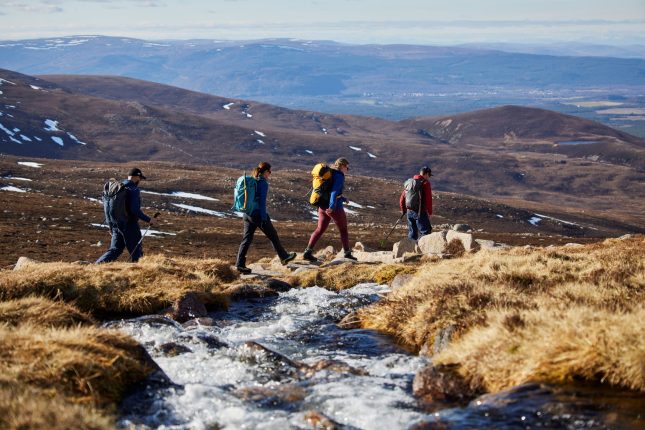Spring Hillwalking
Spring is approaching here in the Cairngorms, and we’re looking forward to milder and longer days ahead. It’s a great time of year to get out on the hills as nature begins to burst into life again, whether it’s your first time heading out, you’ve taken a break for the winter or have been braving the chill and snowy conditions. To help get prepared for the coming season, we asked Instructor Fi Chappell who delivers some of our Hill & Mountain Skills courses some questions about spring hillwalking.
What do you pack in your kit bag for spring hillwalking days out?
I’ll use a fairly well-sized rucksack, say 30/35 litres, as having space for extra layers is always useful.
The safety kit comes first and is packed in a dry bag at the bottom of my rucksack – personal first aid kit, a blizzard blanket, a spare compass if I’m going out on my own, an emergency lightweight pair of mitts and a buff. I’ll also include an emergency headtorch which lives in my first aid kit. I also carry a small group shelter. Hopefully this is all kit that will stay in the bottom of my bag!
Next, I will have a warm, synthetic jacket for emergencies; spring days can still be chilly so the extra layer to throw on for any stops is essential.
After wearing full shell waterproofs pretty much all winter, it can feel quite strange and comfortable to change to lighter softshell clothing and of course, the waterproofs may still be appropriate to carry depending on the forecast. Being able to windproof myself is important to me as even on a sunny day, a breeze can still make itself felt with the effect of wind chill.
I’ll have a hat and gloves for using, sunglasses and sun cream depending on the forecast and trekking poles are also in my bag.
Near the top of my bag is always food and drink that I know I will enjoy and want to eat on the hill.
My map, compass, and watch will all be easily accessible, and I’ll pack my fully charged phone which has useful mapping software and apps such as OS Locate. Again, if I’m out on my own, there will be a spare map too.
Do you bring an ice axe and crampons with you?
When I’m packing for spring hillwalking, I’ll always seek specific information to inform this decision. If there is snow on the hills and the temperature drops then it may well be possible to encounter hard snow on steep slopes, especially if there have been low temperatures overnight with clear skies causing the snow to firm up. You may be anticipating only small patches of snow, in which case an ice axe may be sufficient as it can be used to cut steps over a short stretch. When in doubt, it’s better to have crampons and an ice axe with you and end up not needing them rather than attempt to cross an area of snow unequipped and have a fall.

How do you plan for a spring hill day?
For me, the planning of a spring day begins with looking at the weather and seeing where is best to go. I am very gradually ‘bagging’ Munros and Corbetts so these lists and guidebooks provide inspiration, but it will be the weather that will influence me the most. Met Office and the Mountain Weather Information Service (MWIS) are useful resources of weather information. The Scottish Avalanche Information Service (SAIS) may also be useful as the forecasts continue for some areas into mid-April if there is significant snow on the hills.
I’ll look at the wind speeds and direction, if there is precipitation, and the temperature throughout the day and what the weather has been doing for the past few days. Will the ground underfoot be boggy after rainfall or dry? Will I be following paths or tracks or creating my own route up a hill or mountain? Is there likely to be an effect on water levels in rivers due to melting snow, and could this make stream crossings a challenge?
It’s also important to consider that the paths on maps are shown for summer conditions when there is no snow, so this will influence route choice. Paths that climb up through steep, north facing corries may still hold snow which, after a cold night, may require the use of crampons or the planning of a different route. Old deep snow drifts can still hide streams at usual crossing points, which will either need to be crossed with caution or require a detour to a safer crossing point.
Planning in advance usually sees me having a variety of ideas for journeys. As the day draws nearer these plans start to become more defined but still keeping flexibility in mind.
Any handy hints and tips?
Keep the planning flexible and have lots of ideas to get the best out of the day.
Pack kit into dry bags for ease of finding and especially for wet days to keep spare kit dry.
Trekking poles are useful for stream crossings and also for getting over boggy ground and heathery moorland.
Plan good view points or sheltered spots to stop for snack and photo breaks!
As we head into summer, how do you vary your planning and kit selection?
My planning doesn’t vary that much; I’ll still look at the weather first, but if we have benign, settled conditions then the weather won’t drive my choice of destination quite as much.
The length of journey may be longer as we have more daylight, and in mid-summer there can be days with very little darkness so longer trips that take me into more remote places may be possible.
My route choice may be more influenced by where I can pick up water on a long hot day, and I may carry a small water filter for this purpose depending on where I am going. Water is heavy to carry yet it is important to stay well hydrated.
I’ll pack a lightweight warm hat and thin pair of gloves with my emergency to replace the buff and warm mitts. And a sunhat, sunglasses and suncream will be accessible near the top of my bag.
Clothing can also be lighter though I will still include windproof clothing and a spare warm jacket or fleece.
Midge repellent and a midge net for those still, humid days when the midges have come out are a must!
Some hill walks to inspire and what you liked about them?
My first trip to the Creag Meagaidh hills was from Aberarder up to Carn Liath and along to Stob Poite Coire Ardair. It was a beautifully sunny spring day in mid-April with stunning views and the ridge was clear of snow except for the descent from the Window where the snow was soft enough to run down. We watched a skier descend and decided that we needed to learn to ski for ourselves!
Not all great hill days need to be big days out. One of my favourites is Schiehallion near Aberfeldy with its amazing views over Loch Rannoch; whilst there is a good path up to the summit, you can continue your journey down its northwest ridge for a lovely traverse on a shorter day out.
Making the most of settled summer conditions, we headed up through Rothiemurchus Forest into the Lairig Ghru then up the Sron na Lairig ridge to the summit of Braeriach. We arrived on the summit at around 03:00 just as the sun was rising and a blaze of red and orange light filled the horizon to the east.
About Fi

I am a Summer, Winter, and International Mountain Leader and Rock Climbing Instructor. When I’m not working in the hills, then most likely I am out playing in them especially in winter; skiing, climbing, walking, and just having adventures!
Feeling inspired to get out and enjoy the hills?
Our Hill & Mountain Skills course provides you with the skills to competently and independently explore the UK’s amazing hill & mountain environments, and an opportunity to build your confidence as you learn from our expert Instructors
Discover Navigation is a fantastic one day course that requires no previous experience, and gives you a solid foundational understanding of key navigational skills.
If you’re looking to brush up on or consolidate your navigation skills, our Further Navigation course allows you to develop your knowledge and understanding.